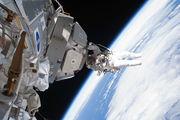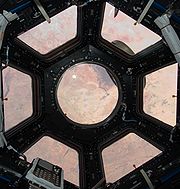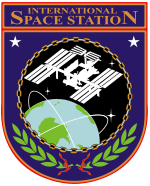Cupola (ISS module)
The Cupola is an ESA-built observatory module of the International Space Station (ISS). It is used to observe experiments and dockings. It was launched aboard Space Shuttle mission STS-130 on 8 February 2010 and attached to the Tranquility (Node 3) module. With the Cupola attached, ISS assembly reached 85 percent completeness. The cupola is the largest window ever used in space.
Overview

External view of the Cupola with window shutters open.
The Cupola provides an observation and work area for the ISS crew giving visibility to support the control of the space station remote manipulator system and general external viewing of Earth, celestial objects and visiting vehicles. Its name derives from Italian word cupola, which means dome. The Cupola was provided by ESA in exchange for the transport of five external payloads. It is extremely important to the ISS astronauts, as previously they have been confined to looking out of small portholes or at best the 20-inch (50 cm) window in the US Destiny laboratory. The Cupola is berthed onto the down-facing port of Node 3—the final of three modules, including Node 1 and Node 2.
Design and construction
Designed and built by the Italian contractor Thales Alenia Space (formerly Alenia Spazio), it is approximately 2 metres in diameter and 1.5 metres tall. It has six side windows and a top window, all of which are equipped with shutters to protect them from damage by micrometeorites and orbital debris. It features a thermal control system, audio, video and MIL-STD-1553 bus interfaces, as well as the connections needed for installing one of the two identical robotic workstations that control the Canadarm2 into it.
Installation

Astronaut Nicholas Patrick hanging on to Cupola

The Sahara desert viewed through the Cupola with its shutters open
The Cupola was launched aboard the Space Shuttle on mission STS-130, on February 8, 2010. It was berthed to the forward port of the Tranquility module for launch, and was later transferred to the nadir-facing port of Tranquility by the Canadarm2, once Tranquility had been berthed to the Unity Module of the ISS. The installation of the Cupola, along with Tranquility, marks one of the last main components to be added to the International Space Station.
Specifications
- Overall Height: 1.5-metre (4.9 ft)
- Maximum Diameter: 2.95-metre (9.68 ft)
- Launch Mass: 1,805-kilogram (3,979 lb)
- On Orbit Mass: 1,880-kilogram (4,145 lb)
- Dome: Forged Al 2219-T851
- Skirt: Al 2219-T851
- Windows: Fused Silica and Borosilicate Glass
- MDPS Shutters: Kevlar/Nextel sheets
- Electrical Power: Node 120 V Interface
- Top Window: 80-centimetre (31 in) Diameter
- Thermal Control: Goldised Kapton Multi-Layer Insulation Blanket
See also
References
External links
|
Components of the International Space Station |
|
| Overview |
Assembly · Expeditions · ISS Program · Scientific Research · Major Incidents
|
 |
|
Major components
in orbit |
Zarya (Functional Cargo Block) · Zvezda (Service Module) · Unity (Node 1) · Harmony (Node 2) · Tranquility (Node 3) · Destiny (Laboratory) · Columbus (Laboratory) · Kibō (PM, ELM-PS, EF) · Quest (Airlock) · Pirs (Airlock / Docking Module) · Rassvet (MRM 1) · Poisk (MRM 2) · Cupola · Integrated Truss Structure (ITS)
|
|
Subsystems
in orbit |
Canadarm2 (MSS) · Dextre (SPDM) · Kibō Remote Manipulator System · External Stowage Platforms (ESPs) · ExPRESS Logistics Carriers 1&2 (ELCs) · Pressurized Mating Adapters (PMAs) · Electrical System · Life Support System
|
|
| Launched periodically |
Multi-Purpose Logistics Modules (MPLMs) · Kibō (ELM-ES)
|
|
| Scheduled for Shuttle |
ExPRESS Logistics Carriers 3&4 (ELCs) · Alpha Magnetic Spectrometer · Leonardo (PMM) · OBSS
|
|
| Scheduled for Proton |
Nauka (Multipurpose Laboratory Module) · European Robotic Arm (ERA)
|
|
| Not currently scheduled |
ExPRESS Logistics Carrier 5 (ELC-5) · Interim Control Module (ICM) · Node 4
|
|
| Cancelled |
Propulsion Module · Centrifuge Accommodations Module (CAM) · Habitation Module · Crew Return Vehicle (CRV/ACRV) · Science Power Platform (SPP) · Universal Docking Module (UDM) · Russian Research Module (RM)
|
|
| Support vehicles |
|
|
| Mission control centers |
|
|
 Book:International Space Station · Book:International Space Station ·  Category:International Space Station · Category:International Space Station ·  Portal:Spaceflight Portal:Spaceflight |
|
|
← 2009 · Orbital launches in 2010 |
|
|
Compass-G1 | Globus-1M #12L | Progress M-04M | STS-130 (Tranquility · Cupola) | SDO | Intelsat 16 | Kosmos 2459 · Kosmos 2460 · Kosmos 2461 | GOES 15 | Yaogan 9A · Yaogan 9B · Yaogan 9C | EchoStar XIV | Soyuz TMA-18 | STS-131 (Leonardo MPLM) | CryoSat-2 | GSAT-4 | Kosmos 2462 | USA-212 | SES-1 | Kosmos 2463 | Progress M-05M | STS-132 (Rassvet · ICC-VLD) | Akatsuki · IKAROS (DCAM-1 · DCAM-2) · Shin'en · Waseda-SAT2 · Hayato · Negai ☆'' | Astra 3B · COMSATBw-2 | USA-213 | SERVIS-2 | Compass-G3 | Badr-5 | Dragon Spacecraft Qualification Unit | STSAT-2B | Shijian XII | Prisma · Picard · BPA-1 | Soyuz TMA-19 | TanDEM-X | Ofek-9 | Arabsat-5A · Chollian | Progress M-06M | EchoStar XV | Cartosat-2B · AlSat-2A · StudSat · AISSat-1 · TIsat-1 | Compass-IGSO1 | Nilesat 201 · RASCOM-QAF 1R | Yaogan 10 | USA-214 | Tian Hui 1 | Kosmos 2464 · Kosmos 2465 · Kosmos 2466 | Chinasat-6A | Gonets-M No.2 · Kosmos 2467 · Kosmos 2468 | Progress M-07M | Michibiki | USA-215 | Yaogan 11 · Zheda Pixing 1B · Zheda Pixing 1C | USA-216 | Kosmos 2469 | Chang'e-2 | Shijian 6G · Shijian 6H | Soyuz TMA-01M | XM-5 | Globalstar 73 · Globalstar 74 · Globalstar 75 · Globalstar 76 · Globalstar 77 · Globalstar 79 | Progress M-08M | Eutelsat W3B · BSat 3B | Compass-G4 | Meridian 3 | Feng Yun 3B | COSMO-4 | SkyTerra-1 | STPSat-2 · RAX · O/OREOS · FASTSAT (NanoSail-D2) · FalconSat-5 · Sara-Lily · Emma | USA-223 | Chinasat-20A | Intelsat 17 · Hylas 1 | Glonass-M No.39 · Glonass-M No.40 · Glonass-M No.41 | Dragon C1 · CAREUS · SMDC-ONE 1 · Colony 1A · Colony 1B · TBC
|
|
| Payloads are separated by bullets ( · ), launches by pipes ( | ). Manned flights are indicated in bold text. Uncatalogued launch failures are listed in italics. Payloads deployed from other spacecraft are denoted in (brackets). |
|



